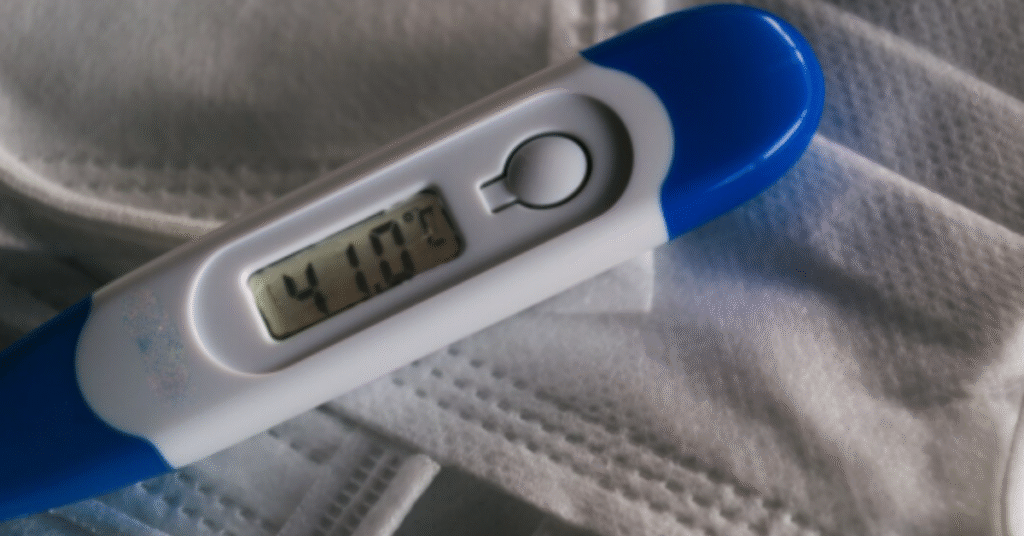In an age where precision and convenience shape medical technology, the digital thermometer stands as one of the most practical yet vital innovations in healthcare. Designed to measure body temperature with unmatched accuracy and speed, it has become an indispensable tool for households, hospitals, and research institutions alike. A digital thermometer converts thermal readings into digital data, displaying temperature in seconds. Unlike traditional mercury thermometers, it offers enhanced safety, faster readings, and the ability to record temperature history—features essential for modern health monitoring. Whether used for fever detection, clinical diagnostics, or industrial temperature control, its significance is undeniable. This article explores the science, structure, and societal importance of digital thermometers, offering readers a comprehensive view of how this small device has revolutionized our approach to health assessment. By the end, you’ll understand its design, technology, and applications in both personal and professional settings.
The Evolution of Temperature Measurement
The journey of temperature measurement dates back centuries, beginning with the invention of the mercury thermometer by Daniel Gabriel Fahrenheit in the early 18th century. While groundbreaking at the time, mercury thermometers presented significant limitations: they were fragile, slow to respond, and posed toxicity risks due to mercury exposure. The digital thermometer emerged as a safer and more advanced alternative in the late 20th century, leveraging electronic sensors instead of liquid metals. Its ability to provide instant readings and eliminate human error in interpretation reshaped the healthcare industry. This shift not only marked progress in measurement technology but also aligned with global efforts to reduce hazardous materials in medical tools. Today, digital thermometers have diversified into contact, non-contact, and smart variants, adapting seamlessly to both clinical precision and home convenience. As technology continues to evolve, their capabilities expand far beyond fever detection, venturing into remote monitoring and data analytics.
How a Digital Thermometer Works
At its core, a digital thermometer operates using electronic sensors—primarily thermistors or infrared detectors—that translate temperature into electrical signals. When the sensor detects body heat, it changes its resistance proportionally to the temperature. The device’s microprocessor then interprets this data, displaying a readable numerical value on the screen. The process typically takes between 5 to 15 seconds, depending on the model. Unlike analog thermometers that rely on physical expansion, digital thermometers depend on signal conversion and calibration algorithms, ensuring consistent results. The integration of microcontrollers and advanced circuitry enables accuracy within ±0.1°C. Moreover, modern variants include features like automatic shut-off, memory storage, and fever alerts. Infrared thermometers, a subset of digital technology, can measure temperature from a distance using radiation detection—a vital feature for minimizing contact during pandemics. This fusion of physics and microelectronics highlights how science continues to refine health diagnostics.
Types of Digital Thermometers
Digital thermometers come in various designs, each tailored to specific needs and environments. The most common types include oral, rectal, axillary, tympanic, and infrared thermometers. Oral thermometers are the most widely used for personal health monitoring, offering reliable readings when placed under the tongue. Rectal thermometers, often used for infants, provide the most accurate core temperature readings. Axillary thermometers measure underarm temperature and are favored for their ease of use, though they may show slightly lower values. Tympanic thermometers use infrared sensors to measure the eardrum’s heat radiation, delivering near-instant results. Non-contact infrared thermometers, however, represent the pinnacle of convenience—especially during global health crises—by enabling safe, hygienic, and quick screening. The diversity of these devices reflects how healthcare demands drive continuous innovation, ensuring accessibility for every user group, from newborns to industrial technicians.
Table 1: Comparison of Digital Thermometer Types
| Type of Thermometer | Measurement Area | Accuracy Level | Reading Time | Best Use Case |
|---|---|---|---|---|
| Oral | Mouth (under tongue) | ±0.1°C | 10 seconds | Everyday personal use |
| Rectal | Rectum | ±0.05°C | 15 seconds | Infants and clinical care |
| Axillary | Underarm | ±0.2°C | 20 seconds | Quick household checks |
| Tympanic | Ear canal | ±0.1°C | 5 seconds | Children and adults |
| Infrared (Non-contact) | Forehead | ±0.2°C | 2 seconds | Mass screening and hygienic use |
The Science Behind Temperature Accuracy
Accuracy in a digital thermometer depends on several factors: sensor quality, calibration process, and user handling. High-precision thermistors or infrared detectors form the core of accuracy. Manufacturers calibrate each unit against reference thermometers under controlled conditions, ensuring dependable readings. However, temperature can fluctuate due to ambient influences, such as room temperature or improper positioning. To counter this, modern devices employ algorithms that compensate for environmental variations. Infrared thermometers, for instance, use emissivity correction to adjust for skin reflectivity. In professional healthcare environments, calibration verification remains a critical routine, ensuring compliance with medical standards like ISO and ASTM. The integration of AI-driven temperature mapping in some advanced thermometers represents the next phase—offering adaptive calibration through self-learning systems that enhance accuracy over time.
Key Advantages Over Traditional Thermometers
The shift from mercury to digital thermometers offers profound benefits, reshaping healthcare and household safety. The most evident advantage is speed—digital thermometers can deliver readings in seconds, essential during emergency care or pediatric use. Safety is another critical benefit; without mercury or glass, there’s zero risk of poisoning or injury. Digital storage functions also allow users to monitor temperature trends over days or weeks, aiding in illness tracking. Moreover, smart models can sync with health apps, sending data directly to doctors or caregivers. For hospitals, this minimizes manual recording errors and improves workflow efficiency. Environmental safety is yet another gain; eliminating mercury thermometers helps reduce toxic waste and aligns with sustainable healthcare practices. As medical ecosystems lean toward digitalization, these devices embody both safety and smart functionality.
Table 2: Advantages of Digital Thermometers
| Feature | Digital Thermometer | Mercury Thermometer |
|---|---|---|
| Reading Speed | 5–10 seconds | 60–120 seconds |
| Safety | No mercury, unbreakable | Contains mercury, fragile |
| Accuracy | ±0.1°C | ±0.2°C |
| Data Storage | Yes (in advanced models) | No |
| Environmental Impact | Eco-friendly | Hazardous due to mercury |
Applications Beyond Healthcare
While healthcare remains the primary domain, digital thermometers extend their utility into various industries. In the food sector, they ensure proper cooking and storage temperatures, preventing bacterial contamination. Laboratory and pharmaceutical industries rely on precision temperature monitoring during experiments and medicine formulation. HVAC systems use them for climate regulation, while digital thermocouples in manufacturing ensure optimal material processing. Even within agriculture, farmers use digital thermometers to monitor soil and animal body temperatures, optimizing growth conditions. “Temperature is not just a number; it’s a reflection of balance,” notes Dr. Sara Nguyen, a biomedical engineer specializing in sensor technology. This quote emphasizes how thermometers have evolved from mere diagnostic tools to instruments of control and safety across multiple disciplines.
The Role of Infrared and Smart Technologies
Infrared thermometry, one of the fastest-growing segments, exemplifies how innovation meets necessity. These devices use sensors that detect infrared radiation emitted by objects or skin surfaces, calculating temperature without contact. During the COVID-19 pandemic, their non-invasive operation became vital for mass screening, minimizing cross-contamination risks. Smart thermometers take this a step further—integrating Bluetooth or Wi-Fi connectivity, enabling data logging through mobile apps. They can track family health profiles, notify users of abnormal temperature patterns, and even link with telemedicine platforms for remote diagnosis. The convergence of IoT and healthcare has turned thermometers into real-time health trackers rather than passive tools. This digital ecosystem reinforces the notion that every data point contributes to better preventive care and public health management.
Maintenance and Calibration of Digital Thermometers
Despite their sophistication, digital thermometers require periodic care to ensure consistent accuracy. Regular cleaning, especially for contact models, prevents bacterial buildup. Alcohol wipes or mild disinfectants are recommended for sanitation. Battery replacement should be done according to manufacturer guidelines to avoid power fluctuation errors. Calibration checks, either through comparison with a reference thermometer or a certified calibration bath, verify operational integrity. Industrial and hospital-grade devices may undergo annual professional recalibration. As temperature sensors can drift over time, maintenance ensures longevity and precision. “A thermometer’s value lies not just in its design, but in its upkeep,” says Mark Ellis, a quality assurance technician. This principle underscores that precision instruments, like human health, rely on continuous attention and care.
Environmental Impact and Sustainability
Modern digital thermometers represent a more sustainable alternative to mercury-based devices, which were banned in many countries due to their toxic nature. Electronic components, though non-toxic, still pose recycling challenges. Manufacturers are addressing this by using biodegradable plastics, rechargeable batteries, and modular designs that facilitate part replacement instead of disposal. Some companies have introduced solar-powered thermometers, minimizing battery waste. Additionally, green manufacturing certifications encourage energy-efficient production processes. As sustainability becomes central to healthcare innovation, the digital thermometer symbolizes responsible technology—combining performance with eco-conscious design. Environmental scientists argue that if every household replaced mercury thermometers with digital ones, global mercury pollution could decrease significantly, marking an essential step in public health and environmental safety.
Choosing the Right Digital Thermometer
Selecting the best digital thermometer depends on individual or institutional needs. For home use, oral or infrared forehead thermometers are most practical, offering simplicity and hygiene. Pediatric care often demands rectal thermometers for maximum accuracy. Clinical facilities prefer multi-mode or tympanic models capable of handling continuous use. Industrial users, on the other hand, benefit from thermocouple-based devices that can measure extreme temperatures. Key purchasing factors include accuracy range, response time, calibration options, and additional features like backlighting or connectivity. Reading user manuals and comparing specifications ensures informed decisions. Investing in reliable brands with medical certification guarantees both durability and performance—factors critical in environments where every degree matters.
Common Challenges and Troubleshooting
Digital thermometers, though dependable, can experience minor issues such as inaccurate readings, dead batteries, or sensor malfunction. Incorrect placement is a frequent cause of inconsistent results. For instance, measuring too soon after eating or drinking can distort oral readings. Low battery levels can affect display performance, while exposure to high humidity can damage internal circuitry. To troubleshoot, users should ensure stable ambient conditions, reset devices when needed, and recalibrate if inconsistencies persist. Regular inspection for dust or residue buildup helps maintain precision. If the display flashes an error code, consulting the instruction manual or contacting customer support is advised. Understanding these small technical aspects ensures reliable temperature tracking and prolongs device lifespan.
The Digital Thermometer in the Age of AI
Artificial intelligence is redefining how thermometers interact with human health. Smart thermometers now use AI to analyze long-term patterns, detect fever trends, and even predict illness progression based on temperature fluctuations. These insights, when connected to cloud-based systems, allow healthcare professionals to monitor patients remotely. AI-driven algorithms also improve calibration by learning from historical data, minimizing errors caused by environmental variance. Predictive maintenance, another emerging feature, alerts users before battery or sensor failure occurs. The merging of AI and thermometry could pave the way for predictive health analytics, where temperature data forms part of a larger biometric ecosystem. As AI continues to integrate with medical diagnostics, the humble thermometer is becoming a digital sentinel for proactive healthcare.
Future Innovations in Temperature Technology
The future of temperature measurement looks promising, blending biotechnology with nanotechnology. Researchers are developing wearable thermometers embedded in fabrics or skin patches that provide continuous real-time monitoring. These devices could detect early signs of infection or metabolic imbalance without any active effort from the user. Contactless nanothermometers—built using graphene sensors—promise sub-millisecond readings with extreme accuracy. Integration with smartphones and cloud analytics will further simplify data sharing. As personalization becomes a key trend, thermometers may soon adapt automatically to user preferences, adjusting display brightness, reading units, or response sensitivity. Future models could even synchronize with other smart devices, contributing to an interconnected health ecosystem that values precision, comfort, and prevention equally.
Conclusion
The digital thermometer represents far more than a technological upgrade; it embodies the evolution of human care, convenience, and scientific precision. By replacing hazardous mercury devices, it brought safety and efficiency into every household and clinic. Its ability to connect, store, and analyze temperature data has transformed healthcare into a more intelligent and accessible experience. From infrared innovations to AI-driven diagnostics, the journey of digital thermometry continues to define the intersection of health and technology. As we move into a data-centric world, this small yet powerful device reminds us that innovation’s true purpose lies in safeguarding well-being. “The thermometer doesn’t just measure temperature; it measures trust,” as one physician aptly puts it—symbolizing its role as both a guardian of health and a marker of progress.
FAQs
1. How does a digital thermometer differ from a mercury thermometer?
A digital thermometer uses electronic sensors to detect temperature and displays the result on a screen, while a mercury thermometer relies on thermal expansion of mercury. Digital models are faster, safer, and more accurate, eliminating mercury exposure risks.
2. Can digital thermometers be used for all age groups?
Yes, digital thermometers are suitable for all ages, with specific models designed for infants (rectal), children (tympanic), and adults (oral or infrared). Selecting the correct type ensures optimal accuracy and safety.
3. How often should I calibrate my digital thermometer?
For household use, annual calibration is typically sufficient. However, medical and industrial thermometers may require professional calibration every six months to maintain precision.
4. What’s the best way to clean a digital thermometer?
Wipe the sensor and body with alcohol swabs or mild disinfectants after each use. Avoid immersing the device in water or using abrasive cleaners to prevent sensor damage.
5. Are smart thermometers worth buying?
Smart thermometers offer advanced features like Bluetooth connectivity, data storage, and health tracking. They are ideal for users who monitor temperature frequently or need to share readings with healthcare providers.







